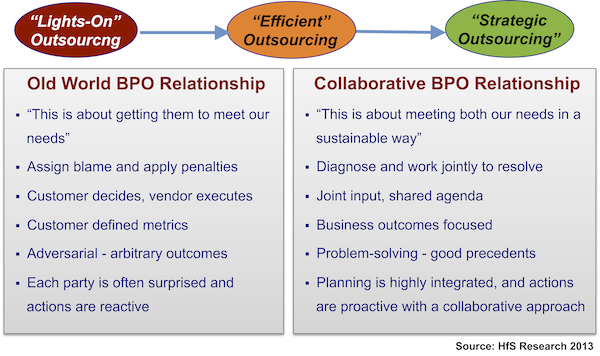
It's never too late to find redemption…
So if you haven’t been fired yet, here’s how to avoid it happening…
Phil Fersht (HfS Research): So, Lee, we talk about more of a fluid and evolving outsourcing relationship. How can we get there? Why is such a large proportion of this industry stuck in the weeds, with so many companies persisting in doing things in such a short-sighted way over the last decade. Why aren’t we evolving these relationships? What is holding us back?
Lee Coulter (Ascension Health): Phil, I think there are two primary reasons:
One is the most common misconception about outsourcing or shared services is that you can declare success. Some executives like to say “We’re done. We’re done outsourcing. We’re done doing shared services”. No, no you can’t! This notion that there is some finite initiative and there is some specific number of deliverables that you can check off on your old checklist and say “Oh I am done, yay”… that is a very common misconception by the leadership in many organizations.
The second one is that the work to continue to evolve the relationship, is really hard work. You know for anybody who has actually been through a significant outsourcing negotiation, it’s hard work. You know, not just to get the MSA in place, statements of work, service level targets, KPI’s, units of cost, demand management processes, these are all hard things to do. They really are pretty hard. And when we have taken the time to describe the nature of our relationship in a contract and it takes you know 6, 9, 12 months to do it and then another 12 months to work the kinks out of that. Nobody really looks at re-characterizing that relationship as something that they really want to do. But, in order for the client to get the best of what a provider has to offer, that’s what needs to happen. And to increase the value and contribution of those services for the business, that’s what has to happen. Continually moving up the value scale to the point where the provider is not only able to bring their expertise and technology to your relationship but has the incentive to do so. You’re in an FTE contract moving to a task based contract, it’s is a minor step. It is a big and important, but minor step.
However, moving into a process component, that is yet another step. Moving up the value chain from purchasing effort to purchasing tasks to result in purchasing processes to finally purchasing the contribution of that service to the business. This incents the provider to bring their own best thinking their own best technology to your services. But it requires that you completely start from scratch with the description of what it is you are buying and how it is you are paying for it, because you have to go through this process every couple of years of looking at what you are purchasing and the way you are purchasing it and say to yourself, “Is this really incenting the right behaviour from both parties?”
Phil: Our data is showing that there is a good chunk of clients today, around a third, who probably have that attitude that outsourcing is done, it’s finished – let’s just keep chugging along with that contract. So, we kind of take the attitude of if that’s the way they approach it, there is not much you can do. But it’s the remaining 66% of clients who have varying degrees of caring about improving and innovating. Would you agree with that, and do you feel that those clients who are in the bottom 33% should be just left to do it their way, or do you need there should be some overall change in the way the industry approaches outsourcing, in general?
Lee: Well, interesting data – It would be interesting to see the segmentation in the 66% and see how they separate out, in terms of what their appetite is for going up the value chain. But for the 33% that kind of describe it as “done”, it’s going to be really hard for a service provider to bring a client from thinking their “done” to convince them that there is more value to be added.
It sounds unfortunate, but I don’t know really what the service provider could do. Having been in outsourcing relationships for the last 15 years, I am sure that these providers are regularly presenting things that they could do for the client and their are conversations about innovation and projects and stuff that they could do, and it would fall on deaf ears. But I would probably encourage providers to look at a way to segment their clients and their service delivery to kind of optimize differently for those clients, on “that’s where they are and that’s where they are going to be”. You are going to be wasting your time trying to do anything else. For the 66% well, I will just leave my answer at that. I would be interested to hear more about how the 66% break down.
Phil: Of the 66% who still actually care about value beyond cost, it’s roughly an even split. You’ve got half of them in the death throes of grappling with antiquated contracts that haven’t been updated in quite some time. But they want to break out of that – they are showing some desire to do that. Then you’ve got the upper echelon 33%, whom we have called the “strategic” camp, who are in more regular dialogue with their providers about defining business outcomes, about trying to align stakeholders more effectively and trying to approach things in a different way. So, we really look at three different camps across the industry – you got “lights on” camp on the left and this “efficiency camp” in the middle that could go either way, and on the right hand side we’ve got this kind of “collaborative strategic camp” who are trying to break out and change:
Today’s outsourcing industry split into three camps
Lee: How does this compare, or is that kind of a snapshot of current state?
Phil: It’s the first time we have really broken it out this way. I think the way to look at this is to realize most enterprise BPO engagements have only really been around for ten years and I think companies are kind of feeling their way, since this the first real view of where companies attitudes and approaches are emerging in all of this. Whereas ITO is obviously a lot more mature and we are in a very operational phase in that industry. But also, with ITO, is that you still have 65% of IT staff doing ERP development work that are still based onshore. I think it’s just still a market where it’s a lot of the low-hanging-fruit administrative work that’s still moving out there. I think ITO has really struggled to move up the value chain from the very early days. Is that something you would agree with, or do you think it is evolving?
Lee: Yes. I really would. The complexities of delivering increased value in technology today and I am going to say the permissiveness or the size of the invitation that the client has to provide to the provider is pretty big. Because every time you talk about evolving your technology portfolio, the number of stakeholders and the level of complexity it takes to do that work – it’s really significant.
If a client isn’t really tuned into that and willing to clear the way for the provider to do that work, and not blame them when there are bumps in the road, it’s really tough for a provider to move out of “run and maintain”, and I make the distinction between “run and maintain” and “evolve and re-transform”. So, the business of evolving and re-transforming – that’s where there is change management, communication, training, engaging directly with the business there is all of these things most organizations are not really thrilled about offering to a provider.
Phil: Lee, I can’t wait for our session at dreamSource. Thanks for your time today, this real is the “hard talk track” so many of the sourcing industry needs to have, to get out of its own way.
Lee: A pleasure, Phil, and looking forward to meeting a lot interesting folks there!
Lee Coulter (pictured right) is Senior Vice President and Chief Executive Officer, Ascension Health Ministry Service Center, LLC. As a distinguished practioner in the fields of outsourcing and shared services he has held several senior operations leadership roles at Kraft, AON and GE. Lee also serves on the board if HfS Research. You can view his full bio by clicking here.
Posted in : Business Process Outsourcing (BPO), Captives and Shared Services Strategies, Cloud Computing, Global Business Services, HfSResearch.com Homepage, Outsourcing Events, Outsourcing Heros, Sourcing Best Practises, Talent in Sourcing









[…] Research Services « Why middle management is often as influential as the C-Suite when it comes to outsourcing If outsourcing were an employee, it would be fired… Part 2 » […]
well written article and i liked the table that summed up the discussionas reading is a problem.
It is good to note that there was no real mention of improvements or growth in the o/s’d process
so perfection retained and retrained and restrained I guess…